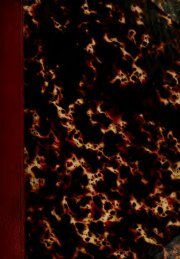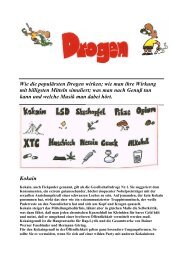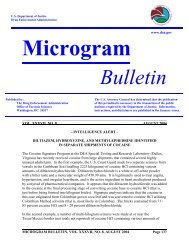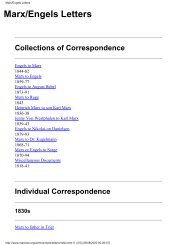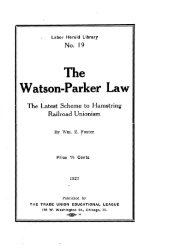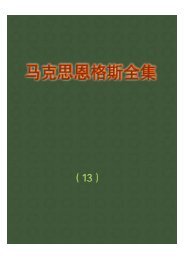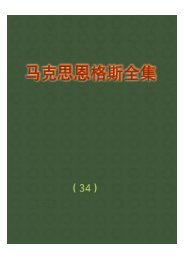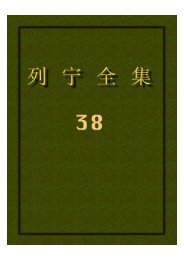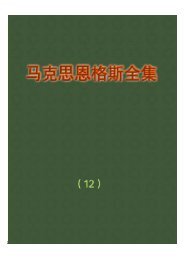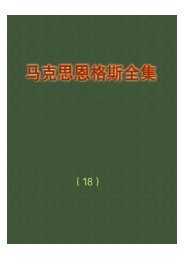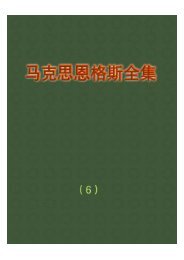MOURA Dinara Jaqueline et al.
MOURA Dinara Jaqueline et al.
MOURA Dinara Jaqueline et al.
Create successful ePaper yourself
Turn your PDF publications into a flip-book with our unique Google optimized e-Paper software.
Table II. Induction of forward mutation (can1) in haploid N123 strain of<br />
Saccharomyces cerevisiae after b-carbolinic <strong>al</strong>k<strong>al</strong>oids treatments in stationary<br />
phase in PBS<br />
Agent Treatment (lg/ml) Surviv<strong>al</strong> (%) Can/10 7 survivors a<br />
NC b<br />
0 100 (237) c<br />
1.05 0.57 d<br />
4NQO e<br />
0.5 45.14 (107)*** 30.28 3.43***<br />
Harmane 10 98.78 (234) 2.54 0.02<br />
25 91.71 (217) 1.98 1.03<br />
50 87.23 (207) 2.55 0.42<br />
Harmine 10 96.55 (228) 1.71 0.45<br />
25 93.13 (221) 1.39 0.52<br />
50 90.72 (215) 2.77 0.36<br />
Harmol 10 90.71 (215) 1.90 0.59<br />
25 88.30 (209) 2.08 0.42<br />
50 86.56 (205) 2.23 0.43<br />
Harm<strong>al</strong>ine 10 96.63 (229) 1.55 0.29<br />
25 95.47 (226) 1.65 0.98<br />
50 93.96 (222) 2.03 0.30<br />
Harm<strong>al</strong>ol 10 92.26 (219) 1.25 0.75<br />
25 91.49 (217) 1.97 0.28<br />
50 89.23 (211) 2.03 0.24<br />
a<br />
Locus-specific revertants.<br />
b<br />
Negative control (solvent).<br />
c<br />
Number of colonies.<br />
d<br />
Mean and standard deviation per three independent experiments.<br />
e<br />
Positive control.<br />
Data significant in relation to negative control group (solvent) at<br />
***P , 0.001/one-way ANOVA–Tukey’s multiple comparison test.<br />
Table III. Effects of b-carbolinic <strong>al</strong>k<strong>al</strong>oids on induced mutagenicity by H 2O 2<br />
in haploid N123 strain of Saccharomyces cerevisiae in the stationary phase<br />
in PBS<br />
Agent Treatment Surviv<strong>al</strong> (%) Can/10 7 survivors a<br />
NC b<br />
0 100 (247) c<br />
1.02 0.12 d<br />
e<br />
H2O2 4 mM 42.10 (104) 19.29 2.08<br />
Harmane<br />
Harmine<br />
Harmol<br />
Harm<strong>al</strong>ine<br />
Harm<strong>al</strong>ol<br />
10 lg/ml þ H2O2<br />
25 lg/ml þ H2O2<br />
50 lg/ml þ H2O2<br />
10 lg/ml þ H2O2<br />
25 lg/ml þ H2O2 50 lg/ml þ H2O2 10 lg/ml þ H2O2 25 lg/ml þ H2O2<br />
50 lg/ml þ H2O2<br />
10 lg/ml þ H2O2<br />
25 lg/ml þ H2O2<br />
50 lg/ml þ H2O2 10 lg/ml þ H2O2 25 lg/ml þ H2O2<br />
50 lg/ml þ H2O2<br />
74.89 (185)<br />
69.73 (172)<br />
67.20 (166)<br />
70.85 (175)<br />
60.42 (149)<br />
55.46 (137)<br />
79.77 (197)<br />
72.82 (180)<br />
61.34 (152)<br />
65.47 (162)<br />
67.26 (166)<br />
73.99 (183)<br />
68.70 (170)<br />
74.89 (185)<br />
71.25 (176)<br />
5.67<br />
6.99<br />
9.64<br />
5.95<br />
7.49<br />
13.5<br />
4.46<br />
4.93<br />
10.92<br />
4.44<br />
6.68<br />
7.59<br />
8.88<br />
4.38<br />
1.98<br />
0.80***<br />
0.10**<br />
1.81**<br />
0.38***<br />
1.11**<br />
1.57*<br />
0.57***<br />
0.41***<br />
2.26*<br />
0.22***<br />
1.66**<br />
3.15**<br />
1.30**<br />
0.32***<br />
0.19***<br />
a Locus-specific revertants.<br />
b Negative control (solvent).<br />
c Number of colonies.<br />
d Mean and standard deviation per three independent experiments.<br />
e Positive control (H2O 2).<br />
Data significant in relation to positive control group at *P , 0.05, **P , 0.01<br />
and ***P , 0.001/one-way–ANOVA Tukey’s multiple comparison test.<br />
oxidative stress induced by H2O2, and it has been shown that<br />
there is a strong relationship b<strong>et</strong>ween cat<strong>al</strong>ase and SOD activities<br />
under different experiment<strong>al</strong> conditions. Therefore, the lack of<br />
SOD as well as of cat<strong>al</strong>ase activities imputes sensitivity to H2O2.<br />
Thus, we believe that the protective effect against paraquat<br />
toxicity can be due to the direct action against H2O2 or against<br />
OH_ radic<strong>al</strong> generated through the Haber-Weiss–Fenton re-<br />
Table IV. Effects of b-carbolines <strong>al</strong>k<strong>al</strong>oids in V79 cells exposed for 2 h and<br />
ev<strong>al</strong>uated by com<strong>et</strong> assay<br />
Substance Treatment DI a<br />
NC b<br />
MMS c<br />
DF (%) a<br />
0 46.00 4.00 49.00 2.00<br />
4.0 10 5 M 227.00 4.35*** 86.00 9.84***<br />
Harmane 10 lg/ml 80.00 8.93 41.33 3.05<br />
20 lg/ml 84.33 3.79 58.00 3.00<br />
40 lg/ml 182.71 6.19** 69.66 1.57*<br />
Harmine 10 lg/ml 74.00 16.28 54.33 4.61<br />
20 lg/ml 81.01 0.73 65.66 6.42<br />
40 lg/ml 113.2 4.58* 71.64 1.82*<br />
Harmol 10 lg/ml 82.68 5.85 54.33 3.53<br />
20 lg/ml 80.02 13.89 56.00 2.00<br />
40 lg/ml 103.33 7.57* 58.30 14.97<br />
80 lg/ml 150.00 12.76*** 72.00 5.29**<br />
Harm<strong>al</strong>ine 10 lg/ml 49.66 20.42 35.66 10.96<br />
20 lg/ml 66.34 11.93 50.60 7.8<br />
40 lg/ml 80.67 10.42 52.62 4.72<br />
80 lg/ml 79.00 13.51 54.00 7.20<br />
Harm<strong>al</strong>ol 10 lg/ml 55.38 6.65 48.66 10.96<br />
20 lg/ml 58.66 4.60 50.00 4.35<br />
40 lg/ml 63.05 2.83 52.66 10.59<br />
80 lg/ml 62.33 15.53 53.65 8.62<br />
a<br />
Means v<strong>al</strong>ues and standard deviation obtained from average of 100 cells per<br />
experiment—tot<strong>al</strong> of four experiments per dose for each substance.<br />
b<br />
Negative control (solvent).<br />
c<br />
Positive control.<br />
Data significant in relation to negative control (solvent) groups at *P , 0.05,<br />
**P , 0.01 and ***P , 0.001/one-way ANOVA–Tukey’s multiple<br />
comparison test.<br />
Table V. Effect of b-carboline <strong>al</strong>k<strong>al</strong>oids in V79 cells exposed for 2 h plus<br />
oxidant H2O2 for 0.5 h and ev<strong>al</strong>uated by com<strong>et</strong> assay<br />
Substance Treatment DI a<br />
NC b<br />
Antioxidant properties of b-carboline <strong>al</strong>k<strong>al</strong>oids<br />
DF (%) a<br />
0 46.35 4.83 22.45 6.11<br />
c<br />
H2O2 100 lM 219.66 36.08 86.36 6.35<br />
Harmane<br />
Harmine<br />
Harmol<br />
Harm<strong>al</strong>ine<br />
Harm<strong>al</strong>ol<br />
10 lg/ml þ H2O2 20 lg/ml þ H2O2<br />
10 lg/ml þ H2O2<br />
20 lg/ml þ H2O2<br />
10 lg/ml þ H2O2<br />
20 lg/ml þ H2O2 10 lg/ml þ H2O2 20 lg/ml þ H2O2 40 lg/ml þ H2O2<br />
10 lg/ml þ H2O2<br />
20 lg/ml þ H2O2<br />
40 lg/ml þ H2O2<br />
92.33<br />
122.00<br />
106.00<br />
123.33<br />
92.66<br />
108.66<br />
106.33<br />
107.66<br />
106.00<br />
86.33<br />
112.33<br />
115.33<br />
13.79***<br />
6.00***<br />
21.96***<br />
24.58*<br />
11.60***<br />
19.03***<br />
11.93***<br />
7.57***<br />
1.73***<br />
12.85***<br />
8.38***<br />
17.00***<br />
41.33<br />
58.00<br />
55.66<br />
67.33<br />
44.33<br />
56.33<br />
60.00<br />
50.33<br />
54.33<br />
50.00<br />
49.66<br />
54.66<br />
3.05***<br />
3.00**<br />
6.42**<br />
2.30<br />
2.51***<br />
2.00**<br />
7.80***<br />
15.71***<br />
4.61***<br />
11.36***<br />
4.93***<br />
3.51***<br />
a<br />
Mean v<strong>al</strong>ues and standard deviation obtained from average of 100 cells per<br />
experiment—tot<strong>al</strong> of four experiments for each substance.<br />
b<br />
Negative control (solvent).<br />
c<br />
Positive control (H2O2).<br />
Data significant in relation to positive control (oxidant) group at *P , 0.05,<br />
**P , 0.01 and ***P , 0.001/one-way ANOVA–Tukey’s multiple<br />
comparison test.<br />
action, since there are evidences demonstrating that these<br />
<strong>al</strong>k<strong>al</strong>oids are not active against superoxide anions in vitro when<br />
tested using SOD-inhibitable reduction ferricytochrome c (36).<br />
It is <strong>al</strong>so important to note the antioxidant response observed<br />
in the yap1 mutants for most <strong>al</strong>k<strong>al</strong>oid treatments, especi<strong>al</strong>ly for<br />
the dihydro-b-carbolines (Figures 3D, 3E, 4D and 4E). Yap1<br />
is a key regulator of oxidative stress tolerance in S. cerevisiae,<br />
and has been shown to regulate a broad s<strong>et</strong> of genes in response<br />
to oxidative stress, including TRX2 (thioredoxin), TRR1<br />
299<br />
Downloaded from<br />
mutage.oxfordjourn<strong>al</strong>s.org by guest on May 16, 2011



